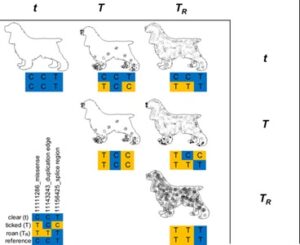The Ticking, or T-Locus, corresponds to the usherin gene (USH2A), which helps control the development of the dog’s coat pattern. T-Locus mutations in dogs cause the development of alternating areas of white and pigmented hairs, which can result in two distinct patterns: Ticked and Roan.
A Ticked coat features dark, pigmented spots in otherwise white areas of the body. These spots tend to be the most common on the legs and muzzle. A Roan coat features a mostly even mixture of white and pigmented hairs on areas of the body that would otherwise be pure white. Roan puppies are likely to have clearly separate areas of dark and white hairs on their coat. As they age, these areas become more intermingled.
Inheritance
Ticked and Roan are Autosomal Co-Dominant traits. A dog carrying both the Ticked and Roan mutations will develop a combination of the two patterns. Ticking and Roan are both dominant over a clear (unpatterned) coat.

This image shows examples of the Ticked and Roan patterns with the different mutations, Brancalion et al. 2021.
t/t: Clear coat
T/t and T/T: Ticked coat
Tr/t and Tr/Tr: Roan coat
Tr/T: Roan – Ticked coat
Relevant Tests
• H763
References
Brancalion L, Haase B, Mazrier H, et al. Roan, ticked and clear coat patterns in the canine are associated with three haplotypes near usherin on CFA38. Anim Genet. 2021;52(2):198-207. doi:10.1111/age.13040